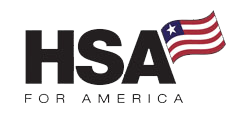Health Savings Accounts (HSAs), are among the most potent savings tax savings and wealth accumulation tools available to individual taxpayers in the tax code.

And unlike most tax advantages, deductions, and loopholes, which tend to benefit independent contractors, small businesses and corporations, and investors, the tax benefits of health savings accounts are also available to ordinary statutory W-2 employees, in many cases – provided they’re covered under a qualified high deductible health plan, or HDHP.
Furthermore, if you’re eligible to contribute to an HSA, or if you have assets in an old HSA, you can benefit directly from your HSA, even if you don’t itemize deductions.
This article will discuss HSA eligibility under the tax code, as well as the tax treatment of HSA contributions, growth, distributions, and the disposition of HSAs when the insured dies and the assets go to heirs or to the deceased HSA owner’s estate.
Disclaimer: HSA for America does not provide individual tax advice. The information in this article is for general information purposes only and is not intended to constitute tax advice. For information specific to your situation, you should additionally engage the services of a qualified tax professional.
Overview: About Health Savings Accounts
Health savings accounts (HSAs) were created by Public Law 108-173, the Medicare Prescription Drug, Improvement and Modernization Act of 2003, signed into law by President George W. Bush on December 8, 2003.
The purpose of creating HSAs was to assist individual taxpayers in saving for qualified medical expenses and certain retiree health benefits.
Any U.S. individual taxpayer over age 18 who is covered under a qualified high deductible health plan and has no other first-dollar medical coverage (e.g., Medicaid, Veterans Administration, or TRICARE) can open an HSA and contribute pre-tax dollars.
Additionally, employers can also contribute to employee HSAs on their workers’ behalf. These contributions are tax deductible to the employer, and tax-free to the employee. They are also generally exempt from payroll taxes, as well.
HSAs make it easier for you to save pre-tax dollars and tax-deferred dollars to pay tax free for out-of-pocket medical expenses on everything from deductible and copays to doctors’ office visits to ER charges to prescription drugs, durable medical equipment, lab fees, imagery costs, vehicle modifications, and much more.
Since HSAs were created 21 years ago, they’ve grown into a major savings and investment vehicle and a significant contributor to the financial security of millions of American families.
As of the end of 2022, assets in health savings accounts surpassed $100 billion across 35.5 million accounts, covering some 75 million Americans, according to information from Devinir.
The Amazing Triple Tax Benefits of Health Savings Accounts
Dollar for dollar, HSA are arguably the single most powerful tax savings and wealth accumulation vehicle available to individual taxpayers.
They offer a triple tax benefit unmatched by any other tax-advantaged savings or wealth accumulation vehicle in the tax code:
- Employer contributions are pre-tax, and your own contributions are tax deductible on your federal tax return. This means that you can save money on your taxes now, and put that money towards your health care expenses later.
- Growth in the HSA is tax-deferred. This means that the money in your HSA grows tax-free, so you can save even more money for the future.
- Withdrawals to pay for qualified medical expenses are tax-free. Distributions (withdrawals) from HSAs are tax free – as long as they are used to pay for qualified medical expenses.
HSA Penalties for Non-Qualified Distributions
While withdrawals from HSAs to pay for qualified medical expenses are tax-free and penalty-free, there is a steep 20% penalty on any withdrawals you make prior to turning 65 that are not attributable to a qualified medical expense.
From the tax perspective, this is the chief downside of HSAs: if you are forced to make withdrawals for non-medical purposes, the penalty is steep – even steeper than the penalty for early withdrawals from 401(k) plans.
HSAs as a Retirement Asset
HSAs can be a great retirement savings vehicle as well. Any money you contribute to an HSA that you don’t need for medical expenses becomes available to you penalty-free when you turn age 65. All you need to do is pay income taxes on amounts you withdraw for retirement income – just as you would with an IRA.
But even after age 65, you can still use your HSA assets to pay for qualified medical expenses, tax free.
I discuss more details about how the HSA can be a valuable tax-advantaged retirement asset below.
Compare Pricing on the Best HSA Plans Available
HSA Contribution Limits
As of tax year 2024, you can contribute up to $4,150 for self-only coverage and $8,300 for family coverage to a health savings account.
Those 55 and older can contribute an additional $1,000 as a catch-up contribution.
There are no income caps for HSA contributions. Unlike traditional IRAs, which have income limits on the amount of income you can earn and still take a deduction for IRA contributions, you can make a pre-tax contribution to an HSA no matter how much you earn.
However, you cannot contribute more than your earned income for the plan year.
Contributions to your HSA made by your employer (including contributions made through a cafeteria plan) may be excluded from your gross income. This means these amounts will be free of income tax as well as Social Security and payroll taxes.
If you have an employer contributing to your HSA on your behalf, or you are an employer contributing to a worker’s HSA, these contribution limits apply to both the employers’ and the employees’ contributions combined.
HSA Eligibility Criteria
To be eligible to open and contribute to an HSA, you must meet the following criteria:
- You must be an U.S. citizen or resident alien.
- You must be covered by a high deductible health plan (HDHP).
- You must have no other health insurance coverage that is primary to your HDHP.
- You must be at least 18 years old.
If you meet all of these criteria, you can open an HSA and start contributing money to save for your future medical expenses. HSAs are a great way to save money on your health care costs and have tax-free money available when you need it most.
Learn More: How Much Can an HSA Save in Taxes?
What is a High Deductible Health Plan (HDHP?)
A high deductible health plan (HDHP) is a type of health insurance plan that has a high deductible, but lower monthly premiums than traditional health insurance plans with lower deductibles, all other things being equal.
HDHP Minimum Annual Deductible
As of 2024, the minimum annual deductible for an HDHP is $1,600 for self-only coverage and $3,200 for family coverage.
HDHP Maximum Out-Of-Pocket Costs
Under federal law, the maximum out-of-pocket costs you should pay for all your deductibles, co-insurance costs, and copays under an HSA-qualified high-deductible health plan are $8,050 for a self-only plan, and $16,100 for a family plan.
Some plans may have lower out-of-pocket caps.
Under these max out-of-pocket thresholds, your HDHP plan will cover 60% (bronze plans), 70% (silver plans), 80% (gold plans), or 90% (platinum plans) of costs over your deductible for covered services. But once you’ve paid out your maximum out of pocket, your HDHP will pay 100% of all covered medical goods and services.
Learn More: What Is a High Deductible Health Plan?
Combining HSAs and Health Sharing Accounts
Until recently, only business owners, independent contractors, and people with self-employment income could contribute to an HSA while enrolled in a health sharing plan rather than a qualified HDHP traditional health insurance plan.
That was by enrolling in HSA SECURE, a specially-designed health sharing plan with a unique structure: It’s built around a qualified minimum essential coverage plan designed to meet the bare bones requirements to qualify as an HDHP.
It’s economical and affordable, and typically costs just around half of what you’d pay for a full-fledged HSA-compatible high deductible health plan without a subsidy. And it still has the robust cost-sharing power of a health sharing plan that can handle even catastrophic medical events.
HSA SECURE is still on the market, and it’s still a compelling solution.
But if you’re a business owner, independent contractor, or have verifiable self-employment income, recent innovations in the field have made it possible for you to contribute to an HSA while enrolled in ANY health sharing plan: Purchase standalone minimum essential coverage policy to work alongside your existing health sharing plan.
To find out more, contact a Personal Benefits Manager, and ask about HSA MEC.
Learn More: At Last: You Can Combine Health Sharing With HSAs. Here’s How.
HSA Contribution Deadlines
In general, you can make HSA contributions for the previous tax year until April 15th of the following year – the same as the tax deadline for traditional and Roth IRA contributions.
For example, if you were covered under a qualified HDHP in 2024 and otherwise eligible, you (or your employer) can make pre-tax contributions to your HSA until April 15th, 2025.
In some years, the tax filing deadline may fall on a weekend or holiday, which may push the actual contribution deadline for that year back by 1-3 days.
For example, residents of Maine and Massachusetts have until April 17 to file their federal income taxes because April 15 is Patriots’ Day and April 16 is Emancipation Day, and they are official state holidays.
But the contribution deadline is always the tax filing deadline for the tax year ending December 31st of the previous plan year, without extensions, for your state.
HSA Portability
Unlike many other employee benefits, such as employer-sponsored group health insurance plans, HSAs are fully portable.
That means that your HSA is your property, and the account and all the assets in it stay with you after you leave the workforce or your employer. This is true even if your employer made some or all of the contributions to your HSA on your behalf.
Your employer contributions vest to you immediately. If you quit your job today, every dollar your employer has contributed to your HSA leaves with you.
Leaving your employer or leaving the workforce has no effect on your HSA and is not a taxable event.
HSAs as a Retirement Asset
Required Minimum Distributions
A required minimum distribution (RMD) is a minimum amount that must be withdrawn from certain retirement accounts each year, such as 401(k)s, 403(b)s, and traditional IRAs.
You have to pay taxes on these amounts withdrawn.
But HSAs are not subject to RMDs. Here’s why:
First, HSAs are designed to be used for medical expenses, and the government does not want to force people to withdraw money from their HSAs if they do not need it for medical care. Congress wants those funds available to help them pay for medical expenses and long-term care insurance premiums, even in retirement.
Second, HSAs are tax-advantaged accounts, and the government does not want to discourage people from using them by imposing RMDs.
Third, HSAs are portable, and the government does not want to force people to take distributions from their HSAs if they change jobs or lose their health insurance.
If you have an HSA, you can choose to leave your money in the account and let it grow tax-free. You can also withdraw money from your HSA to pay for qualified medical expenses. If you do not need to use your HSA money for medical expenses, you can leave it in the account and let it grow tax-free indefinitely. You can even pass your HSA to your heirs.
HSA Contributions in Retirement
Once you enroll in Medicare, you may no longer make contributions to your HSA.
However, you can continue making pre-tax HSA contributions even after age 65, as long as you delay enrolling in Medicare. Many people do this while remaining on an employer’s health plan after age 65.
Sometimes, one member of a married couple will continue making HSA contributions while the other spouse enrolls in Medicare. In this case, the non-Medicare spouse can still make the larger married couple contributions, plus any allowable over 55 catch-up contributions.
Caution: Under the so-called “six month rule,” also called the “six-month lookback period,” your Medicare Part A coverage actually begins six months before you actually apply.
That means you will be ineligible to contribute to an HSA during that period. If you’re contributing to your HSA right up to the deadline, it’s easy to mistakenly make ineligible contributions within that six month window.
If you’re planning on enrolling in Medicare within the next year, or your spouse may enroll in Medicare, it’s important to consult with your tax advisor to avoid making this common HSA mistake.
What Are Qualified Medical Expenses?
Medical expenses are the costs of diagnosis, cure, mitigation, treatment, or prevention of disease, and for the purpose of affecting any part or function of the body.
These expenses include payments for legal medical services rendered by physicians, surgeons, dentists, and other medical practitioners.
They include the costs of equipment, supplies, and diagnostic devices needed for these purposes.
However, these expenditures must be attributable to an actual diagnosed medical condition. Costs incurred for general wellness purposes are not considered qualified medical expenses for HSA purposes.
That means any withdrawals you attempt to distribute to these goods or services will not qualify for tax-free treatment. You may also have to pay an additional penalty of 20% of the amount you take out, if you are under 65.
Can I pay for mileage incurred for medical treatment using my HSA?
Yes. As of 2024, the IRS will allow tax-free withdrawals of up to 22 cents per mile incurred for travel for medical treatment, or to conferences related to your medical condition or that of a covered family member.
HSAs, HDHPs, and Telehealth Services
In 2022, Congress amended the law to allow HDHPs to set a deductible of $0 for telehealth and other remote care services for plan years beginning after 2022 and before 2025.
HDHPs and Insulin
In the same year, Congress also authorized HDHPs to set a $0 deductible for selected insulin products.
HSAs and Section125 Cafeteria Plans
A Section 125 plan – also called a cafeteria plan, cafeteria plan is a type of employee benefit plan that allows employees to choose between different benefits, such as health insurance, dental insurance, vision insurance, disability insurance, life insurance, and more.
Typically, employees will choose which benefits in the cafeteria plan make sense for them, and pay for them or contribute via payroll deduction.
Contributions made to a Section 125 plan are exempt from federal income tax, Social Security tax, and Medicare tax. This can save employers a significant amount of money on payroll taxes.
It’s also more tax-efficient for employees, as well. Pre-tax contributions via payroll deductions aren’t just free of ordinary income tax, but they are also deducted before Social Security and Medicare taxes.
If you as the employee contribute your own money, outside of your employers’ Section 125 plan, you’ll still get the ordinary income tax deduction. But your actual contribution will come out of money that has already been subject to payroll taxes when you got paid by your employer.
Learn More: The HSA For America Guide to Section 125 Cafeteria Plans
HSA Related Tax Forms
HSA owners and business owners and HR professionals in companies that contribute to employees’ HSAs should be familiar with the following HSA-related tax forms:
There are four IRS forms related to health savings accounts (HSAs): Form 1099-SA, Form 5498-SA, Form 8889, and W-2.
- Form 1099-SA is used to report distributions from an HSA. This form is filed by individuals who received HSA distributions.
- Form 5498-SA is used to report contributions to an HSA. This form is filed by individuals and employers who made HSA contributions.
- Form 8889 is used to report HSA contributions, distributions, and the individual’s eligibility for the HSA tax break. This form is filed by individuals who made HSA contributions or received HSA distributions.
- W-2 is used to report wages, tips, and other compensation paid to employees. This form is filed by employers.
Tax Penalty on Excess HSA Contributions
If you and/or your employer accidentally contribute too much to your HSA, and exceed the legal limit, you may face a 6% penalty of the excess amount until you remove the excess from your account.
You have until April 15th (or the tax filing deadline for that year, if other than April 15th) to correct the oversight. Be sure to make a formal “excess contribution removal” request with your HSA administrator or custodian, so that their reporting to the IRS will be correct.
HSAs vs FSAs
Health Savings Accounts (HSAs) and Flexible Spending Accounts (FSAs) are both tax-advantaged savings accounts that can be used to pay for medical expenses.
However, there are some key differences between the two accounts.
- Account Ownership. HSAs are owned by the individual, while FSAs are owned by the employer. This means that HSA funds are portable and can be taken with you if you change jobs, while FSA funds are subject to an employer-withdrawal rule.
- Use-it-or-Lose-it Rules. HSA contributions vest to you immediately, even if your employer makes the contribution to your HSA on your behalf. HSA assets are not subject to forfeiture or “use-it-or-lose-it” rules. This is in contrast to FHAs, which require you to use your benefits within a certain amount of time, or forfeit them back to your employer.
- Eligible Expenses HSA funds can be used for any qualified medical expense – even for medical costs incurred years ago. FSA funds, in contrast, can only be used for eligible medical expenses that are incurred during the plan year.
HSAs and Limited Purpose FSAs
Employees can enroll in both an HSA and an FSA.
But if the employee is making HSA contributions, the FSA can only be a limited purpose FSA. That’s that it is restricted to specific expenses, such as dental or vision, not covered by a high-deductible insurance plan.
HSAs and FSAs can both be valuable tools for saving money on medical expenses. However, it is important to understand the differences between the two accounts in order to choose the one that is right for you.
Learn More: Boost Your Company’s Benefits Package With a Small Business HSA: A Step-By-Step Guide
Advanced HSA Planning Tips
Deferring HSA Distributions
Increasingly, financial advisors and benefits brokers are recommending investing as much as you can into your health savings account – and then not using it to pay medical expenses.
Instead, this strategy calls for using cash and other taxable resources to pay your out-of-pocket health care costs. And then letting your HSA funds grow unmolested and tax-deferred for decades.
The idea: You can deduct most out-of-pocket medical expenses above 7.5% of your AGI anyway. But you’ll get much more long-term benefit from decades of tax-deferred growth to pay for much greater anticipated medical expenses in retirement – when you are likely to have much greater healthcare-related expenses, such as long term care insurance premiums – that you can pay for using your HSA.
And when you do use your HSA to pay for any kind of qualified medical expense in retirement (or at any other time), the tax-deferred growth turns into a tax-free benefit.
Why? Because investing HSA funds for the long term can leverage so-called “triple-tax” benefits, which can stretch money even further.
Compare Pricing on the Best HealthShare Plans Available
The HSA Adult Child Loophole
Another not-widely-understood strategy is the HSA Adult Child Loophole.
This loophole allows parents to pay qualified medical expenses for their adult children with tax-free dollars, even if they aren’t dependents, or covered under their parents’ health insurance plan.
The “loophole” is in the definition of the word “dependent: The IRS defines “dependent” differently with respect to HSAs than they do for the more generally applicable income tax rules.
Normally, you can only use HSA funds to pay for tax-free expenses for the account holder, the account holder’s spouse, and any dependents.
For most applications, once an adult child turns 19 (or 24 if they are a full-time student), they usually no longer qualify as a dependent for tax purposes.
But IRS rules allow for an exception for HSAs.
For HSA purposes, the IRS allows you to use HSA funds for your adult children who are not considered dependents for income tax purposes, as long as they meet these three criteria:
- They must be under the age of 26,
- They must not have provided more than half of their own support during the year,
- They must be a U.S. citizen, national, or resident.
The adult child loophole doesn’t work for every family. But when it does work, and your adult child needs medical care, this strategy can help your family save a good deal in taxes.
If you are considering using the HSA adult child loophole, it is important to talk to your financial advisor to make sure you understand the rules and how it can benefit you.
When it comes to taxes and paying for healthcare, every little edge counts. That’s why nearly everyone who qualifies to make HSA contributions should consider opening an HSA account and doing so.
To learn more about HSAs, or to enroll in an HSA-qualified plan, make an appointment for a consultation with an HSA For America Personal Benefits Manager today.
There’s never any charge. And you could potentially save tens of thousands of dollars in taxes over your lifetime, or even more, by contributing aggressively to an HSA.
Key Takeaways:
- Triple Tax Advantage: HSAs offer a unique triple tax benefit – contributions are tax-deductible, earnings grow tax-free, and withdrawals for qualified medical expenses are tax-free.
- No Income Limits: Unlike some other tax-advantaged accounts, there are no income limits for contributing to an HSA, making it accessible to anyone covered by a high-deductible health plan (HDHP).
- Retirement Flexibility: After age 65, HSA funds can be withdrawn for non-medical expenses without penalty (though they are subject to income tax), making HSAs a valuable retirement savings tool.
- Contribution Limits: For 2024, the annual HSA contribution limits are $4,150 for individuals and $8,300 for families, with an additional catch-up contribution of $1,000 for those 55 and older.
Disclaimer: HSA For America does not provide tax advice. This article is for general information purposes only and should not be construed to be individual tax advice.
For information regarding your specific situation, you should consult with a qualified tax professional.
For Further Reading:

Hi! I’m Misty Berryman, and I’m one of your Personal Benefits Managers. I like working with HSA for America because we’re creating solutions to healthcare problems. Our focus on money-saving alternatives like HSA plans and health sharing programs, and the variety of health share programs we offer, are what set us apart. Read more about me on my Bio page.


